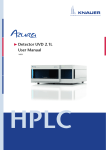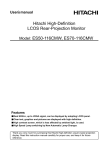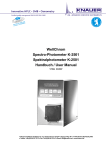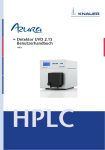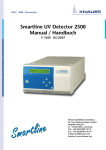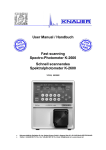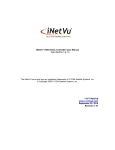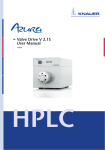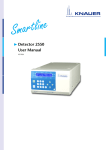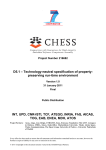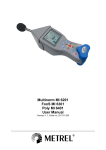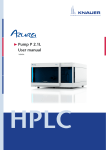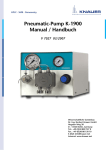Download AZURA UVD 2.1S user manual
Transcript
Detector UVD 2.1S User Manual V6820 HPLC Note: The contents of this user manual apply for the BlueShadow product. Please submit a request on any article numbers for BlueShadow. Table of Contents 3 Table of Contents Note: For your own safety, be sure to read the manual and always observe the warnings and safety information on the device and in the manual! Intended Use. . . . . . . . . . . . . . . . . . . . . . . . . . . . . . . . . . . . . . . . . . . . . . . . . Device Overview . . . . . . . . . . . . . . . . . . . . . . . . . . . . . . . . . . . . . . . . . . . . Features . . . . . . . . . . . . . . . . . . . . . . . . . . . . . . . . . . . . . . . . . . . . . . . . . . Eluents . . . . . . . . . . . . . . . . . . . . . . . . . . . . . . . . . . . . . . . . . . . . . . . . . . . 5 5 6 7 Scope of Delivery . . . . . . . . . . . . . . . . . . . . . . . . . . . . . . . . . . . . . . . . . . . . . 8 Safety for Users . . . . . . . . . . . . . . . . . . . . . . . . . . . . . . . . . . . . . . . . . . . . . . . 8 Definition of Personal and Material Damages . . . . . . . . . . . . . . . . . . . . . 10 Symbols and Signs . . . . . . . . . . . . . . . . . . . . . . . . . . . . . . . . . . . . . . . . . . . 11 Unpacking and Setup . . . . . . . . . . . . . . . . . . . . . . . . . . . . . . . . . . . . . . . . . Contacting the Technical Support . . . . . . . . . . . . . . . . . . . . . . . . . . . . . . Location Requirements . . . . . . . . . . . . . . . . . . . . . . . . . . . . . . . . . . . . . . Power supply . . . . . . . . . . . . . . . . . . . . . . . . . . . . . . . . . . . . . . . . . . . Space Requirements . . . . . . . . . . . . . . . . . . . . . . . . . . . . . . . . . . . . . . Unpacking . . . . . . . . . . . . . . . . . . . . . . . . . . . . . . . . . . . . . . . . . . . . . . . Connectors on the Rear Side . . . . . . . . . . . . . . . . . . . . . . . . . . . . . . . . . . Control via the spring strip . . . . . . . . . . . . . . . . . . . . . . . . . . . . . . . . . Analog Control . . . . . . . . . . . . . . . . . . . . . . . . . . . . . . . . . . . . . . . . . Ground . . . . . . . . . . . . . . . . . . . . . . . . . . . . . . . . . . . . . . . . . . . . . . . 12 12 12 12 13 13 13 14 14 15 16 16 Initial Startup . . . . . . . . . . . . . . . . . . . . . . . . . . . . . . . . . . . . . . . . . . . . . . . Installing the Flow Cell . . . . . . . . . . . . . . . . . . . . . . . . . . . . . . . . . . . . . . Setting the Optical Path Length of a Preparative Flow Cell . . . . . . . . . Connecting the Capillaries . . . . . . . . . . . . . . . . . . . . . . . . . . . . . . . . . . . Switching the Detector On . . . . . . . . . . . . . . . . . . . . . . . . . . . . . . . . . . . 17 17 18 19 20 Spring Strip Assignments . . . . . . . . . . . . . . . . . . . . . . . . . . . . . . . . . . . . . . . . . . . . Pin Header for Remote Control . . . . . . . . . . . . . . . . . . . . . . . . . . . . . . . . . . . . . . . . Operation . . . . . . . . . . . . . . . . . . . . . . . . . . . . . . . . . . . . . . . . . . . . . . . . . . 21 Basic Operation at the Device . . . . . . . . . . . . . . . . . . . . . . . . . . . . . . . . . 21 UVD 2.1S User Manual V6820, Version 2.3 4 Table of Contents Control of the Device . . . . . . . . . . . . . . . . . . . . . . . . . . . . . . . . . . . . . . . Menu Structure . . . . . . . . . . . . . . . . . . . . . . . . . . . . . . . . . . . . . . . . . Control . . . . . . . . . . . . . . . . . . . . . . . . . . . . . . . . . . . . . . . . . . . . . . . Activating/Deactivating the Lamp . . . . . . . . . . . . . . . . . . . . . . . . . . . Adjusting the Chromatogram . . . . . . . . . . . . . . . . . . . . . . . . . . . . . . Smoothing output signal . . . . . . . . . . . . . . . . . . . . . . . . . . . . . . . . . . . . . . . . . . . . Adjusting V/AU ratio . . . . . . . . . . . . . . . . . . . . . . . . . . . . . . . . . . . . . . . . . . . . . . . . Checking the Deuterium Lamp . . . . . . . . . . . . . . . . . . . . . . . . . . . . . Displaying Operating Hours . . . . . . . . . . . . . . . . . . . . . . . . . . . . . . . . . . . . . . . . . . Using the Analog Port . . . . . . . . . . . . . . . . . . . . . . . . . . . . . . . . . . . . Setting the Zero Point . . . . . . . . . . . . . . . . . . . . . . . . . . . . . . . . . . . . . . . . . . . . . . Entering a Scaling Value . . . . . . . . . . . . . . . . . . . . . . . . . . . . . . . . . . . . . . . . . . . . . Control with Chromatography Software . . . . . . . . . . . . . . . . . . . . . . . . . Local Area Network (LAN) . . . . . . . . . . . . . . . . . . . . . . . . . . . . . . . . . Serial interface . . . . . . . . . . . . . . . . . . . . . . . . . . . . . . . . . . . . . . . . . . 22 23 24 24 25 25 25 26 26 26 26 27 27 27 28 Functionality Tests IQ and OQ . . . . . . . . . . . . . . . . . . . . . . . . . . . . . . . . . . 28 Maintenance and Care . . . . . . . . . . . . . . . . . . . . . . . . . . . . . . . . . . . . . . . . Maintenance Contract . . . . . . . . . . . . . . . . . . . . . . . . . . . . . . . . . . . . . . Cleaning and Caring for the Device . . . . . . . . . . . . . . . . . . . . . . . . . . . . What Maintenance Tasks can Users Perform on the Device? . . . . . . . . . . Cleaning the Flow Cell . . . . . . . . . . . . . . . . . . . . . . . . . . . . . . . . . . . . . . Rinsing the Flow Cell . . . . . . . . . . . . . . . . . . . . . . . . . . . . . . . . . . . . . Cleaning the Lens of an Analytical Flow Cell . . . . . . . . . . . . . . . . . . . . Cleaning the Light Guide of a Preparative Flow Cell . . . . . . . . . . . . . . Replacing the Flow Cell . . . . . . . . . . . . . . . . . . . . . . . . . . . . . . . . . . . . . . Replacing the Fiber Optics . . . . . . . . . . . . . . . . . . . . . . . . . . . . . . . . . . . Removing the Fiber Optics . . . . . . . . . . . . . . . . . . . . . . . . . . . . . . . . . 29 29 30 30 31 31 32 33 34 35 35 Technical Data. . . . . . . . . . . . . . . . . . . . . . . . . . . . . . . . . . . . . . . . . . . . . . . 37 Accessories and Spare Parts . . . . . . . . . . . . . . . . . . . . . . . . . . . . . . . . . . . . Devices and Accessories . . . . . . . . . . . . . . . . . . . . . . . . . . . . . . . . . . . . . Fiber Optic Connectors . . . . . . . . . . . . . . . . . . . . . . . . . . . . . . . . . . . Available Flow Cells . . . . . . . . . . . . . . . . . . . . . . . . . . . . . . . . . . . . . . . . . Preparative Flow Cells . . . . . . . . . . . . . . . . . . . . . . . . . . . . . . . . . . . . Fiber Optics Preparative Flow Cells . . . . . . . . . . . . . . . . . . . . . . . . . . . Test Cells . . . . . . . . . . . . . . . . . . . . . . . . . . . . . . . . . . . . . . . . . . . . . . 38 39 39 39 40 42 43 Disposal . . . . . . . . . . . . . . . . . . . . . . . . . . . . . . . . . . . . . . . . . . . . . . . . . . . . 43 Index . . . . . . . . . . . . . . . . . . . . . . . . . . . . . . . . . . . . . . . . . . . . . . . . . . . . . . 44 Declaration of Conformity . . . . . . . . . . . . . . . . . . . . . . . . . . . . . . . . . . . . . 46 UVD 2.1S User Manual V6820, Version 2.3 Intended Use 5 Intended Use Note: Only use the device for applications that fall within the range of the intended use. Otherwise, the protective and safety equipment of the device could fail. Device Overview The detector is a measuring device that is used for measuring UV spectra quickly and precisely. 1 2 3 Fig. 1 Detector UVD 2.1S front view Legend 1 Display 2 Keyboard 3 Flow cell 1 2 7 3 4 6 5 Fig. 2 Detector UVD 2.1S rear view UVD 2.1S User Manual V6820, Version 2.3 6 Intended Use Legend 4 5 6 7 1 RS-232 port 2 LAN port 3 Pin header Integrator Output Connection Ground Fan Operating range The detector can be used in analytical and preparative HPLC system. It is used in laboratories to analyze substance mixtures. In a HPLC system, the detector serves to detect substances in liquids and show their concentration. The device can be used in the following areas: Biochemistry analysis Chemical analysis Food analysis Pharmaceutical analysis Environmental analysis The detector is, e. g., used at universities, research institutions, and routine laboratories. Features One of the smallest HPLC detectors on the market. The deuterium lamp measures spectra between 190 nm to 500 nm. A wide range of flow cells for analytical or preparative LC applications with flow rates from 10 μl/min up to 10 l/min. Automatic recognition and storage of device-specific information, which are important for Good Laboratory Practice, Operation Qualifications (OQ), for repairing the device. Automatic and current diagnosis of the device Control with chromatography software or with the front panel. Easy integration of the detector into complex chromatography systems Options Various types of flow cells are available to the user. Pay attention to the compatability of the flow cells (see “Accessories and Spare Parts” on page 38). Note: A test cell is preassembled to the device. Before the detector can be used for measurements the test cell has to be replaced by a flow cell. The UVD 2.1S Fiber Optics Version is delivered without a test cell. UVD 2.1S User Manual V6820, Version 2.3 Intended Use 7 Eluents Even small quantities of other substances, such as additives, modifiers, or salts can influence the durability of the materials. The list of selected solvents was compiled based on research in the pertinent literature and is only a recommendation. If there is any doubt, contact the Technical Support of the manufacturer. Not suitable eluents Halogenated hydrocarbons, e.g. Freon® Concentrated mineral and organic acids Concentrated bases Eluents containing particles Perfluorinated eluents, e. g. Fluorinert® FC-75, FC-40 Perfluorinated polyether, e.g. Fomblin® Less suitable eluents Dimethyl sulfoxide (DMSO) Slightly volatile eluents Methylene chloride Tetrahydrofuran (THF) Dilute phosphoric acid Suitable eluents Acetone at 4°-25° C (39.2°-77.0° F)a Acetonitrile Benzene Chloroform Ethyl acetate Ethanol Hexane/heptane at 4°-25° C (39.2°-77.0° F) Isopropanol Carbon dioxide (liquid 99.999% CO2) Methanol a. valid for the specified temperature range UVD 2.1S User Manual V6820, Version 2.3 8 Scope of Delivery Suitable eluents Phosphate buffer solutions (0.5 M) Toluol Dilute ammonia solution Dilute acetic acid (10-50%), at 25° C/77.0° F Dilute sodium hydroxide (1M) Water Scope of Delivery Note: Only use original parts and accessories made by KNAUER or a company authorized by KNAUER. Detector with test cella Power cord Power unit Accessory Kit UVD 2.1S Accessory Kit AZURA User Manual (EN/DE) Installation Qualification Documents (EN/DE) Transport securing device (standard detector only) a. Test cell not supplied with Fiber Optics Version Safety for Users Professional group The user manual is addressed to persons that are qualified as chemical laboratory technicians or have completed comparable vocational training. The following knowledge is required: Basic knowledge of liquid chromatography Knowledge regarding substances that are suitable only to a limited extent for use in column liquid chromatography Knowledge regarding the health risks of chemicals Participation during an installation of a device or a training by the company KNAUER or an authorized company. UVD 2.1S User Manual V6820, Version 2.3 Safety for Users 9 If you do not belong to this or a comparable professional group, you may not perform the work described in this user manual under any circumstances. In this case, please contact your superior. Personal Safety Equipment for Professional Group When working with the device, take measures according to lab regulations and wear protective clothing: safety glasses with side protection protective gloves overall What must be taken into account? All safety instructions in the user manual The environmental, installation and connection specifications in the user manual Observe national and international regulations pertaining to laboratory work! Original spare parts, tools, and eluents made or recommended by KNAUER Good Laboratory Practice (GLP) For the development of methods and validation of devices: Protocol for the Adoption of Analytical Methods in the Clinical Chemistry Laboratory, American Journal of Medical Technology, 44, 1, pages 30-37 (1978) Accident prevention regulations published by the accident insurance companies for laboratory work More safety relevant information is listed in alphabetical order in the following table: Topic Explanations Decontamination Contamination of devices with toxic, infectious or radioactive substances poses a hazard to all persons during operation, repair, sale, and disposal of a device. All contaminated devices must be properly decontaminated. All materials or fluids used for decontamination must be collected separately and disposed of properly. Flammability Organic eluents are highly flammable. Since capillaries can detach from their screw fittings and allow eluent to escape, it is prohibited to have any open flames near the analytical system. Leaks Regularly check if any system components are leaking. UVD 2.1S User Manual V6820, Version 2.3 10 Safety for Users Topic Explanations Solvent tray Risk of electrical shock or short circuit if liquids get into the device's interior. For this reason, place all bottles in a solvent tray. Eluent lines Install capillaries and hoses so as liquids cannot get into the interior in case of a leak. Power strip If several devices are connected to one power strip, always consider the maximum power consumption of each device. Power cable Defective power cables are not to be used to connect the device to the mains power. Self-ignition point Only use eluents that have a self-ignition point higher than 150 °C under normal ambient conditions. Power supply Only connect devices to voltage sources, whose voltage equals the device's voltage. Toxicity Organic solvents are toxic above a certain concentration. Ensure that work areas are always well ventilated! Wear protective gloves and safety glasses when working with the device. UV light Concentrated UV light can disperse from a detector without a flow cell or from the fiber optic connectors, which leads to irritation of the retina. When the flow cell or the fiber optic connectors are replaced, switch the device off and pull the power plug. Where is use of the device prohibited? Never use the system in potentially explosive atmospheres without appropriate protective equipment. For further information, contact the Technical Support of KNAUER (see “Contacting the Technical Support” on page 12). Take the device out of operation At any time, take the device completely out of operation by either switching off the power key or by pulling the power plug. Opening the device The device may only be opened by the Technical Support of KNAUER (see “Contacting the Technical Support” on page 12). Definition of Personal and Material Damages Possible dangers related to the device may be divided into personal and material damages in this user manual. UVD 2.1S User Manual V6820, Version 2.3 Symbols and Signs Category 11 Explanations DANGER! Lethal or very serious injuries can occur. WARNING! Serious injuries can occur. CAUTION! Moderate injuries can occur and device defect can occur. Symbols and Signs The following symbols and signs can be found on the device, in the chromatography software or in the user manual: Symbol Meaning High-voltage hazard Electric shock hazard Electrostatic discharge hazard, damages to system, device, or components can occur. General warning sign, moderate injuries can occur and also damages to system, device, or components. UV-light hazard, eye injuries can occur. A device or system marked with CE fulfills the product specific requirements of European directives. This is confirmed in a Declaration of Conformity. UVD 2.1S User Manual V6820, Version 2.3 12 Unpacking and Setup Unpacking and Setup Contacting the Technical Support You have various options to contact the Technical Support: Phone: +49 30 809727-111 Fax: +49 30 8015010 E-mail: [email protected] You can make your requests in English and German. Location Requirements The location for the device must meet the following requirements: level surface for device or system Protect from heavy ventilation Weight: 1.5 kg Dimensions: 121 × 129 × 187 mm (Width × Height × Depth) Power supply: 24 V DC Humidity: below 90 %, non condensing Temperature range: 4 – 40 °C, 39.2 – 104 °F 1 Caution! Defect of the device due to overheating possible. - Set up the device in such a way that it is protected against exposure to direct sunlight. - Keep at least 15 cm clear at the rear and 5–10 cm at each side for air circulation. Power supply The device is only suitable for 24 V direct current. Only the supplied power unit is to be used to connect the device to the mains supply. Replace defective power unit only with original accessories from KNAUER. Only use power units with a permission for use from your country. In case of queries contact the Technical Support Note: Make sure that the power plug on the rear of the device is always accessible, so that the device can be disconnected from the power supply. UVD 2.1S User Manual V6820, Version 2.3 Unpacking and Setup 13 Space Requirements Side clearance to other devices: At least 5 cm, if there is another device on one side. At least 10 cm, if there are devices set up on both sides. At least 15 cm on the rear panel for the fan. Unpacking Store all packing materials. Included packing list should be kept for repeat orders. Tools Utility knife Caution! Damage to the flow cell caused by carrying the detector incorrectly! Lift the detector up with your hands grasping the side panels. Procedure 1. Check for damages caused during transportation. In case you notice any damage, contact the Technical Support and the forwarder company. 2. Set up the delivery so the label is in the correct position. Using the utility knife, cut the adhesive tape. Open the delivery. 3. Remove the foam inserts. Take out the accessories kit and the manual. 4. Open the accessories kit and take out all accessories. Check the scope of delivery. In case any parts are missing, contact the Technical Support. 5. Grip the device at its side panels near the middle and lift it out of the packaging. 6. Remove the foam inserts from the device. 7. Check for damages caused during transportation. In case you notice any damage, contact the Technical Support. 8. Set up the device in its appropriate location. 9. Remove the protective foil and transportation securing device (standard detector only). Connectors on the Rear Side All connectors are located on the rear side of the detector. UVD 2.1S User Manual V6820, Version 2.3 14 Unpacking and Setup 1 2 7 3 4 6 5 Fig. 3 Detector UVD 2.1S rear view Legend 4 5 6 7 1 RS-232 port 2 LAN port 3 Spring strip Integrator Output Connection Ground Fan External devices like computers, fraction collectors, etc. can be connected in 3 different ways to the detector: Connected via the spring strip (remote connector) Connected via LAN within a network Connected via RS-232 Control via the spring strip Caution! Electrostatic discharge can destroy the electronics. Wear a protective bracelet against electrostatic discharge and ground. The spring strip is used for remote control. The single ports transport start, control and error signals. Spring Strip Assignments Connection Function GROUND Reference point of the voltage at the signal inputs. UVD 2.1S User Manual V6820, Version 2.3 Unpacking and Setup Connection Function AUTOZERO A signal (short circuit to GROUND) sets the measuring signal to zero. ERROR IN/OUT IN: After receiving a signal (short circuit to GROUND) from an external device, an error message appears and the device stops. 15 OUT: An error signal is active for as long as an error is displayed e.g. the lamp does not start. GROUND Reference point for external analog control of the detector. ANALOG IN Allows external analog control of the detector when the option ANALOG has been selected in the SETUP menu. The control voltage must be applied against GROUND. Start IN After receiving a signal (short circuit to GROUND) from an external device, the device starts. If controlled via software, an electronic trigger is sent via LAN. Pin Header for Remote Control To control one device through another, you use the multi-pin connector. To use remote control, you have to connect cables to the terminal strip (everything comes included with delivery). The single ports are used to exchange control signals. Prerequisites The device has been turned off. The power plug has been pulled. Tools Depressor tool Caution! Short-circuit hazard. - Turn off the device before connecting it to the multi-pin connector. - Pull the power plug. Caution! Electrostatic discharge can destroy the electronics. Wear a protective bracelet against electrostatic discharge and ground. UVD 2.1S User Manual V6820, Version 2.3 16 Unpacking and Setup Process Figure 1. Place the terminal strip 3 on a suitable surface. 2. Push the depressor tool 1 into the opening on the upper side. 3. Continue pushing the depressor tool down and lead the cable 2 into the front end of the terminal strip. 4. Remove the depressor tool. 5. Check whether the cables are tightly attached. 6. Plug the terminal strip onto the multi-pin connector. 1 2 3 Fig. 4 terminal strip Next steps Finish the installation and perform the initial startup. Analog Control Using the analog port, you can control the wavelength by changing the applied voltage. The analog control must first be selected in the SETUP menu. The control voltage must be applied against GROUND (see “Using the Analog Port” on page 26). To use the analog port for controlling the detector, you have to set a zero point and enter a scaling value. Zero point at 0 V = 000 nm Scaling: 100 nm per Volt If 5 V voltage is applied, the wavelength is 500 nm. Ground Voltages, which may influence the measuring result, can be discharged if the device is connected to a grounded device, e. g., a thermostat. Tools Depressor tool Note: When connected to a 24 V power supply, the detector is not grounded. UVD 2.1S User Manual V6820, Version 2.3 Initial Startup Process 17 Figure 1. Remove 5 mm of insulation from the ends of the cable 2. 2. Using the depressor tool, open the port Ground 1 on the spring strip. 3. Insert the first cable end. 1 2 4. Connect the second cable end to the port Ground on the spring strip of a grounded 220 V KNAUER device 3. 3 The physical connection is established. Initial Startup Note: Before the detector is ready for use, a flow cell must be installed. Before installing the flow cell, the optical path length in the flow cell can be changed. The optimal path length depends on the type and the quantity of the sample. Installing the Flow Cell The test cell has no connectors for capillaries and must therefore be replaced by a flow cell before first usage. Prerequisite Detector has been switched off. Power plug has been pulled. UVD 2.1S User Manual V6820, Version 2.3 18 Note: Initial Startup The test cell is used during operation qualifications and must be stored. Process Figure 1. Unscrew the 2 knurled-head screws 1. 2. Pull out the slide 2. 3. Remove the test cell. 1 2 Fig. 5 Removing the slide 4. Insert the flow cell 4 into the slide. 5. Push the slide 3 into the detector. 6. Tighten the knurled-head screws. 3 4 Fig. 6 Assembling the flow cell Flow cell is assembled. The next step is connecting the capillaries. Setting the Optical Path Length of a Preparative Flow Cell WARNING! Irritation of retina through UV light! Concentrated UV light can leak out from the flow cell or the fiber optic connectors. Switch off the device and pull the power plug. Depending on type, the path length is factory set to 2 mm, 3 mm, or 10 mm. You can remove the spacers on one or both sides and hence change the path length to 1.25 mm or 0.5 mm. Prerequisite Flow cell has been disassembled. Tools Allen screwdriver size 3 UVD 2.1S User Manual V6820, Version 2.3 Initial Startup 19 1 2 3 4 5 Fig. 7 Preparative flow cell Legend 3 Spacer 4 Seal holder (compression bushing) 5 Light guide with PTFE seal 1 Threaded ring 2 Cover Procedure 1. Using the allen screwdriver, unscrew and remove the threaded ring 1. 2. Remove the cover 2 and spacer 3. Put the spacer aside. 3. Insert the cover. 4. Using the allen screwdriver, tighten the threaded ring. Enlarging the optical path length To enlarge the optical path length, put in one or both spacers. Connecting the Capillaries Capillaries connect the detector to other devices and lead liquids. Prerequisite Flow cell has been assembled. UVD 2.1S User Manual V6820, Version 2.3 20 Initial Startup Tools Torque wrench Caution! Damage to the flow cell caused by strongly tightened fittings! Check the torque of screw fittings: - 5 Nm for stainless steel fittings - 0.5 Nm for PEEK fittings Note: PEEK fittings withstand a maximum pressure of 400 bar. Process Figure 1. Push the capillary 2 through the fitting 1. 1 2 3 2. Push the clamping ring 3 onto capillary. Fig. 8 Capillary fitting 3. Manually, screw together the capillary and the flow cell 4. To avoid leaks, tighten the fitting 5 with a maximum torque of 5 Nm for stainless steel fittings or 0.5 Nm for PEEK fittings by using the open-end wrench. 4 5 Fig. 9 Capillary and flow cell Result Capillaries have been connected and the detector is ready for operation. Switching the Detector On Caution! Possible damage to the device caused by condensed water! Allow device to acclimate for 3 h, before it is connected to power supply and taken into operation. UVD 2.1S User Manual V6820, Version 2.3 Operation 21 Prerequisite Installation has been completed. Flow cell has been assembled. Procedure 1. Switch off the power supply. 2. Plug the power supply into the device. 3. Connect the power supply and the plug. 4. Plug in the power supply. 5. Using the power-supply switch, switch on the detector. Result The detector starts its self-calibration. The display shows the progress that has been made. When the self-calibration has finished, the status display appears. If the self-calibration fails, switch the detector off and back on. Practical Tipp! Regularly check the capillaries for leaks. Operation The detector can be operated in two ways: Control via the buttons on the front panel Control with chromatography software Basic Operation at the Device The status display shows the values for absorption and wavelength. +0.24626 243 1 2 Fig. 10 Status display Legend 1 Absorption 2 Wavelength Note: When the deuterium lamp has been turned off or is heating, the absorption values are substituted by OFF or HEAT, respectively. There are 3 buttons on the detector that can be used for basic operation. Using the buttons, you can monitor the device and change the settings. UVD 2.1S User Manual V6820, Version 2.3 22 Operation Note: To avoid falsifying measuring values, KNAUER recommends to press the Autozero button before every measurement and after exchanging eluents. Figure Function Keep left arrow key pressed. Scroll using the right arrow key. Press any of the arrow keys to set values and to Fig. 11 Arrow keys o change settings. Initiating an autozero: Absorption is set to 0.000. AZ Fig. 12 Autozero Control of the Device You can control the device using the buttons on the front panel. Handle the buttons in the following manner: Handling 1. Keep left arrow key pressed. Scroll through the menu using the right arrow key. 2. Let go of left arrow key and, using both arrow keys, set the values. UVD 2.1S User Manual V6820, Version 2.3 Operation 23 Menu Structure UVD V01.00 1 Start-up routine 2 Status display +0.24626 243 3 Lamp status LAMP 4 Time constant TC: 5 Integration time Int-Time 2.0ms 6 Light intensity S:0.5670 R:0.3451 7 Control Control LAN DHCP 8 Analog-Out A-OUT 1V 0.01AU 9 Analog-In zero point A-IN set-zero bl Analog-In scaling A-IN bm Lamp operating hours GLP-lamp 1234.1h bn Serial number SN FOP1 12345678 bo Firmware Firmware V01.00 D2 ON HEAT LAMP --- D2 OFF CAL LAMP --- D2 HEA 0.5s Control 9600 0nm SN DOA1 12345678 Abb. 13 Menu structure UVD 2.1S User Manual V6820, Version 2.3 Control ANALOG Control 115200 24 Operation Control Choose between analog or digital ports to control the device accordingly. LAN DHCP: Control with LAN, IP address is obtained automatically (recommended) RS-232 9600: Serial port for cables longer than 2 m RS-232 115200: Serial port for cables with up to 2 m length ANALOG: Control with applied voltage Prerequisite Where applicable: a physical connection has been established. Status display is active. Process Figure 1. Keep left arrow key pressed. Press right arrow key until the correct display appears. 2. Let go of left arrow key. 3. Using both arrow keys, choose a port. Control LAN DHCP Fig. 14 Display port When setting is finished, the status display appears. Activating/Deactivating the Lamp The status display shows not only absorption and wavelength, but also indicates the status of the lamp. HEA: Deuterium lamp is heating. OFF: Deuterium lamp is deactivated. ON: Deuterium lamp is activated. Prerequisite Status display is active. Process Figure 1. Keep left arrow key pressed. Press LAMP D2 right arrow key until the correct OFF display appears. 2. Let go of left arrow key. Fig. 15 Display Lamp 3. Using both arrow keys, activate or deactivate the deuterium lamp. UVD 2.1S User Manual V6820, Version 2.3 Operation 25 When setting is finished, the status display appears. Adjusting the Chromatogram To get a better representation of the chromatogram, you can either smooth the output signal or adjust the voltage/absorption ratio. Smoothing output signal To smooth the output signal, you have to change the values of the time constant. 0.00 s, 0.02 s, 0.05 s, 0.1 s, 0.2 s, 0.5 s, 1 s, 2 s Prerequisite Status display is active. Process Figure 1. Keep left arrow key pressed. Press TC: right arrow key until the correct 0.5s display appears. 2. Let go of left arrow key. Fig. 16 Display time constant 3. Using both arrow keys, set a value. When setting is finished, the status display appears. Adjusting V/AU ratio By assigning different absorption values to a voltage value of 1 V, you can stretch or compress the chromatogram. You can choose the absorption value out of 4 values: 0.01 AU 0.1 AU 1 AU 10 AU Prerequisite Status display is active. Process Figure 1. Keep left arrow key pressed. Press A-OUT 1V right arrow key until the correct 0.01AU display appears. 2. Let go of left arrow key. Fig. 17 Display Analog Out 3. Using both arrow keys, set a value. UVD 2.1S User Manual V6820, Version 2.3 26 Operation When setting is finished, the status display appears. Checking the Deuterium Lamp Note: The deuterium lamp should be checked regularly. According to Good Laboratory Practice (GLP), a deuterium lamp is to be in operation for no longer than 2000 operating hours. Displaying Operating Hours Prerequisite Status display is active. Process Figure 1. Keep left arrow key pressed. Press right arrow key until the correct display appears. 2. Let go of left arrow key. GLP-lamp 1234.1h Fig. 18 Display operating hours of lamp The number of operating hours is displayed and afterwards the status display appears. Next steps If the deuterium lamp has been operating for approximately 2000 hours consider lamp replacement. Using the Analog Port To use the analog port for controlling the detector, you have to set a zero point and enter a scaling value. Setting the Zero Point The zero point is predefined by the applied voltage. Prerequisite Device has been connected to GROUND. ANALOG port has been selected. Process Figure 1. Keep left arrow key pressed. Press right arrow key until the correct display appears. 2. Let go of both arrow keys. 3. Press autozero. A-IN set-zero Fig. 19 Display Analog-In set zero The applied voltage is set as the zero point and is adjusted to 0 nm wavelength. UVD 2.1S User Manual V6820, Version 2.3 Operation 27 Entering a Scaling Value It is recommended to set 500 nm at an applied voltage of 5 V. Prerequisite Device has been connected to GROUND. ANALOG port has been selected. Zero point has been set. Process Figure 1. Apply voltage. 2. Keep left arrow key pressed. Press right arrow key until the correct display appears. 3. Let go of left arrow key. 4. Using the arrow keys, set a value. Do not press autozero. A-IN 0nm Fig. 20 Display Analog-In Scaling When setting is finished, the status display appears. Control with Chromatography Software The detector can be controlled with e. g. OpenLAB EZChrom edition version A.04.05 or higher, ChromGate version 3.3.2 or higher and ClarityChrom version 3.0.7 or higher. You will find a detailed description on the chromatography software in the software manual. There are two advantages to the use of software: Continuous operation for triggered measurement is possible. System status can be checked in the software. To be able to control the detector using chromatography software, the computer must be connected to the device either with a RS-232 cable or a LAN cable. Local Area Network (LAN) A detector connected to a LAN is recognized by the software and automatically receives an IP address because it is set to Dynamic Host Configuration Protocol (DHCP) at the factory. Prerequisite Device has been connected to LAN. Status display is active. UVD 2.1S User Manual V6820, Version 2.3 28 Functionality Tests IQ and OQ Process Figure 1. Keep left arrow key pressed. Press right arrow key until the correct display appears. 2. Let go of left arrow key. 3. Using the arrow keys, set to LAN DHCP. Control LAN DHCP Fig. 21 Display control When setting is finished, the status display appears. Serial interface The user can choose between two ports: 115200: Serial port for cables with up to 2-m length 9600: Serial port for cables longer than 2 m Prerequisite Detector is connected to a computer. Status display is active. Process Figure 1. Keep left arrow key pressed. Press right arrow key until the correct display appears. 2. Let go of left arrow key. 3. Using the arrow key, select the baud rate. Control 9600 Fig. 22 Display control When setting is finished, the status display appears. Functionality Tests IQ and OQ Installation Qualification (IQ) The customer may request the Installation Qualification, which is free of charge. In case of a request, the Technical Support of KNAUER or from a provider authorized by KNAUER performs this functionality test during the installation. The Installation Qualification is a standardized document that comes as part of the delivery and includes the following: confirmation of flawless condition at delivery check if the delivery is complete UVD 2.1S User Manual V6820, Version 2.3 Maintenance and Care 29 certification on the functionality of the device Operation Qualification (OQ) The Operation Qualification includes an extensive functionality test and must be purchased from the manufacturer. Contact the KNAUER Sales Department to request an offer. The Operation Qualification is a standardized KNAUER document and includes the following: definition of customer requirements and acceptance terms documentation on device specifications device functionality check at installation site Test Intervals To make sure that the device operates within the specified range, you should test the device using the Operation Qualification at following intervals: Every 3 months: average useful life of more than 5 days/week or 24 hours/ day; when operating with buffer solutions or other salt solutions: Every 6 months: average useful life of 1 to 5 days/week Execution The test can be carried out either by the Technical Support of KNAUER or from a provider authorized by KNAUER. Maintenance and Care Proper maintenance of your HPLC device will ensure successful analysis and reproducible results. Maintenance Contract The following maintenance work on the device may only be performed by the manufacturer or a company authorized by the manufacturer and is covered by a separate maintenance contract: Opening the device Removing the hood or the side panels. UVD 2.1S User Manual V6820, Version 2.3 30 Maintenance and Care Cleaning and Caring for the Device Caution! Intruding liquids can cause damage to the device. - Place solvent bottles next to the device or in a solvent tray. - Moisten the cleaning cloth only slightly. All smooth surfaces of the device can be cleaned with a mild, commercially available cleaning solution, or with isopropanol. What Maintenance Tasks can Users Perform on the Device? Organic solvents are toxic above a certain concentration. Ensure that work areas are always well-ventilated! When performing maintenance tasks on the device, always wear safety glasses with side protection, protective gloves, and an overall. All wetter components of a device, e. g. flow cells of detectors or pump heads and pressure sensors for pumps, have to be flushed with isopropanol first and water afterwards before being maintained, disassembled or disposed. WARNING! Irritation of retina through UV light! Concentrated UV light can leak out from the flow cell or the fiber optic connectors. Switch off the device and pull the power plug. Caution! Performing maintenance tasks on a switched on device can cause damage to the device. Switch off the device and pull the power plug. Users may perform the following maintenance tasks themselves: Regularly check the operating hours of the deuterium lamp. According to Good Laboratory Practice (GLP), a deuterium lamp is to be in operation for no longer than 2000 operating hours. Inspect the flow cell assembly. Clean the flow cell. Replace the flow cell. Replace the fiber optic connectors (Fiber Optics Version only). Order numbers of the required spare parts can be found in the chapter Accessories and Spare Parts. UVD 2.1S User Manual V6820, Version 2.3 Maintenance and Care 31 Cleaning the Flow Cell Increased baseline noise and reduced sensitivity can be a result of a dirty flow cell. Often it is sufficient to rinse the flow cell to restore optimal sensitivity. Note: Dirty lenses or fiber optic connectors could falsify the measurement. Do not touch the lens or the fiber optic connector lends with bare hands. Wear gloves. Rinsing the Flow Cell The following solvents are recommended for flushing: HCl NaOH Ethanol Acetone Tools Syringe Caution! Contamination of the flow cell caused by oil drops! - Do not use compressed air for drying. Procedure 1. Fill the syringe with flushing solution. 2. Inject it into the inlet of the flow cell and allow it to act for 5 minutes. 3. Fill the syringe with water and inject again. 4. Remove the flow cell from the detector and use a nitrogen stream to dry it. Result Flow cell is clean. Next steps Check, if the baseline noise has disappeared. If the flushing does not have the desired effect, all flow cells can be disassembled to clean the lens. UVD 2.1S User Manual V6820, Version 2.3 32 Maintenance and Care Cleaning the Lens of an Analytical Flow Cell 1 2 3 4 Fig. 23 Analytical flow cell Legend 3 Compression part 4 Threaded ring 1 Seal ring 2 Lens Prerequisite Device has been switched off. Power plug has been pulled. Flow cell has been removed. Tools Tweezers Allen screwdriver, size 3 Procedure 1. Using the allen screwdriver, loosen the threaded ring 4. 2. Using tweezers or by gently tapping on a clean surface, remove the compression part 3. UVD 2.1S User Manual V6820, Version 2.3 Maintenance and Care 33 3. The lens 2 is protected by a seal ring 1. This must be renewed every time the lens is disassembled. 4. Remove the lens and clean with a clean, soft cloth or with water in an ultrasonic bath. 5. Afterwards, assemble the flow cell and make sure that the new seal ring does not interrupt the light path. 6. Using the allen screwdriver, tighten the threaded ring. Result Flow cell can be assembled. What to do when... If the cleaning of the lens does not have the desired effect, the lens has to be replaced. Cleaning the Light Guide of a Preparative Flow Cell The preparative flow cells have a rod shaped light guide instead of the concave lens of the analytical cells. 1 2 3 4 5 Fig. 24 Preparative flow cell UVD 2.1S User Manual V6820, Version 2.3 34 Maintenance and Care Legend 3 Spacer 4 Compression bushing 5 Light guide with seal ring 1 Threaded ring 2 Cover Prerequisite Device has been switched off. Power plug has been pulled. Flow cell has been removed. Tools Tweezers Allen screwdriver, size 3 Procedure 1. Using the screwdriver, loosen the threaded ring 1. 2. Remove the cover 2 and the spacer 3 (not part of all flow cells). 3. Using the tweezers, pull out the compression bushing 4 and the light guide 5. 4. Carefully push the light guide out of the holder and strip off the seal. The seal ring needs to be renewed during every cleaning of the fiber optics. 5. Clean the light guide with a clean, soft cloth or with an appropriate solvent in an ultrasonic bath. Make sure that the clean light guide is not touched by fingers. 6. Afterwards, assemble the flow cell and make sure that the new seal ring does not interrupt the light path. 7. Using the screwdriver, tighten the threaded ring 1. Result Flow cell can be assembled. What to do when... If the cleaning does not have the desired effect, the light guide has to be replaced. Replacing the Flow Cell Prerequisite Detector has been switched off. Power plug has been pulled. Capillaries are disconnected. UVD 2.1S User Manual V6820, Version 2.3 Maintenance and Care Process 35 Figure 1. Unscrew the 2 knurled-head screws 1. 2. Pull out the slide 2. 3. Remove the flow cell. 1 2 Fig. 25 Removing the slide 4. Insert the flow 4 cell into the slide 3. 5. Push the slide into the detector. 6. Tighten the knurled-head screws. 3 4 Fig. 26 Assembling the flow cell Flow cell is assembled. The next step is connecting the capillaries. Replacing the Fiber Optics UV light will cause the fiber optics to become blind with time (solarization), making them no longer suitable for use. Observe the following regarding the use of fiber optics: Do not touch the ends of the fiber optics with your fingers, as this could falsify the measurement. Handle the fiber optics with care, avoid impacts or hard actions. Move the fiber optics carefully without using pressure or bending it. Removing the Fiber Optics Prerequisites The device has been switched off. Tools Cap fittings for the fiber optics Note: Do not touch the ends of the fiber optics with your fingers, as this could falsify the measurement. UVD 2.1S User Manual V6820, Version 2.3 36 Maintenance and Care Process Figure 1. Manually, unscrew the fittings 1 of the fiber optics from the flow cell. 1 Fig. 27 Fiber optics fittings on the flow cell 2. Seal the fiber optic connectors with caps 2. 2 Fig. 28 Cap fittings on the fiber optics 3. Manually, unscrew the fiber optics 3 from the detector. 3 Fig. 29 Fiber optic connectors on the detector UVD 2.1S User Manual V6820, Version 2.3 Technical Data Technical Data Detection Detector type Small variable single wavelength UV detector. Small variable single wavelength UV detector with fiber optics connectors. Detection channels 1 Light source Deuterium (D2) lamp with integrated GLP chip Wavelength range 190–500 nm Spectral bandwidth 13 nm at H line (FWHM) Wavelength accuracy ± 3 nm Wavelength precision 0.7 nm (ASTM E1657-98) Noise ± 2.0 x 10-5 AU at 254 nm ± 2.5 x 10-5 AU at 254 nm (fiber optics version) (ASTM E1657-98) Drift 3.0 x 10-4 AU/h at 254 nm 4.0 x 10-4 AU/h at 254 nm (fiber optics version) (ASTM E1657-98) Linearity > 2.0 AU at 270 nm (ASTM E1657-98) Time constants 0.00/ 0.02/ 0.05/ 0.1/ 0.2/ 0.5/ 1.0/ 2.0 s Integration time Automatic UVD 2.1S User Manual V6820, Version 2.3 37 38 Accessories and Spare Parts Communication Maximum data rate 50 Hz (LAN) 20 Hz (Analog) 10 Hz (RS-232) Input Autozero, Start (IN), Error (either IN or OUT), 0–10 V Analog IN Output Error (either IN or OUT) Analog output 1 x ± 2.5 V scalable, 20 bit Control Digital: RS-232; LAN-DHCP; remote connector Analog: wavelength control Manual: front panel Technical parameters GLP Lamp operating hours Display LED Ambient conditions Temperature range 4–40 °C, 39.2–104 °F Air humidity Below 90%, non condensing General Power supply External: Input 100 - 240 V, output 24 V DC, 60 W Dimensions (Width × Height × Depth) 121 × 129 × 187 mm 121 x 129 x 236 (with flow cell) Weight 1.5 kg Protection type IP 20 Height above sea level maximum 2000 meters Accessories and Spare Parts You will find further information on spare parts and accessories online: www.knauer.net. Note: For repeat orders of spare parts use the enclosed packing list. Contact the Technical Support in case there are any questions on spare parts or accessories. UVD 2.1S User Manual V6820, Version 2.3 Accessories and Spare Parts 39 Devices and Accessories Name Order number AZURA UV Detector UVD 2.1S without flow cell ADA00 AZURA UV Detector UVD 2.1S Fiber Optics Version with- ADA05 out flow cell German user manual English user manual V6820 V6820A Accessories kit FDA AZURA accessories kit FZA01 Deuterium lamp A5193 AZURA tool kit A1033 Repair kit for analytical flow cells A1131 Repair kit for preparative flow cells A1132 Fiber Optic Connectors Name Order number 2 × fiber optic connector 750 mm A0740 1 × fiber optic connector 750 mm A0742 2 × fiber optic connector, custom made size A0743 1 × fiber optic connector 400 mm A0911 Fiber optic coupling A4530 Available Flow Cells Most flow cells are also available equipped with fiber optical connectors for the use with the fiber optics version of the detector. Analytical Flow Cells Technical data Order number Path length 10 mm Connection 1/16“ Inner diameter 1.1 mm Volume 10 μl Material Stainless steel with heat exchanger Max. flow rate 20 ml/min Max. pressure 300 bar UVD 2.1S User Manual V6820, Version 2.3 A4061XB 40 Accessories and Spare Parts Technical data Order number Path length 10 mm A4061 Connection 1/16“ Inner diameter 1.1 mm A4074 (fiber optics version) Volume 10 μl Material Stainless steel with heat exchanger Max. flow rate 20 ml/min Max. pressure 300 bar Path length 3 mm A4042 Connection 1/16“ Inner diameter 1.0 mm A4044 (fiber optics version) Volume 2 μl Material Stainless steel Max. flow rate 50 ml/min Max. pressure 300 bar Path length 3 mm A4045 Connection 1/16“ Inner diameter 1.0 mm A4047 (fiber optics version) Volume 2 μl Material PEEK Max. flow rate 50 ml/min Max. pressure 30 bar Preparative Flow Cells Technical data Order number Path length 0.5 / 1.25 / 2 mm A4066 Connection 1/8“ Inner diameter 2.3 mm A4078 (fiber optics version) Volume 1.7 / 4.3 / 6.8 μl Material Stainless steel Max. flow rate 1000 ml/min Max. pressure 200 bar UVD 2.1S User Manual V6820, Version 2.3 Accessories and Spare Parts Technical data 41 Order number Path length 0.5 / 1.25 / 2 mm A4067 Connection 1/8“ Inner diameter 2.3 mm A4079 (fiber optics version) Volume 1.7 /4.3 / 6.8 μl Material PEEK Max. flow rate 1000 ml/min Max. pressure 100 bar Path length 0.5 / 1.25 / 2 mm A4068 Connection 1/4“ Inner diameter 4.0 mm A4081 (fiber optics version) Volume 1.7 /4.3 / 6.8 μl Material Stainless steel Max. flow rate 10000 ml/min Max. pressure 200 bar Path length 0.5 / 1.25 / 2 mm Connection 1/4“ Inner diameter 4.0 mm Volume 1.7/4.3/6.8 μl Material Stainless steel Max. flow rate 10000 ml/min Max. pressure 200 bar Path length 0.5 mm A4069 Connection 1/16“ Inner diameter 0.8 mm A4089 (fiber optics version) Volume 3 μl Material Stainless steel Max. flow rate 250 ml/min Max. pressure 200 bar UVD 2.1S User Manual V6820, Version 2.3 A4068-2 42 Accessories and Spare Parts Technical data Order number Path length 0.5 mm A4095 Connection 1/16“ Inner diameter 0.8 mm A4096 (fiber optics version) Volume 3 μl Material PEEK Max. flow rate 250 ml/min Max. pressure 100 bar Fiber Optics Preparative Flow Cells Technical data Order number Path length 10 mm Capillary connection 1/2” with TRI-Clamp Material PEEK and fused silica Max. pressure 10 bar Path length 7 mm Capillary connection 3/8” with TRI-Clamp Material PEEK and fused silica Max. pressure 150 bar Path length 0.5/1.25/2 mm Capillary connection 1/2” with TRI-Clamp Material Stainless steel and fused silica Max. pressure 80 bar Path length 0.5/1.25/2 mm Capillary connection 3/4” with TRI-Clamp Material Stainless steel and fused silica Max. pressure 80 bar Path length 0.5/1.25/2 mm Capillary connection 3/8” with TRI-Clamp Material Stainless steel and fused silica Max. pressure 150 bar Path length 0.5/1.25/2 mm Capillary connection 1/4” with TRI-Clamp Material Stainless steel and fused silica Max. pressure 80 bar UVD 2.1S User Manual V6820, Version 2.3 A4154-1 A4152-1 A4154 A4155 A4152 A4153 Disposal 43 Test Cells Technical data Order number Test cell normal A4123 A4125(fiber optics version) Test cell holmium oxide filter A4126 A4128 (fiber optics version) Test cell filter stray light A4146 A4148 (fiber optics version) Disposal Hand in old devices or disassembled old components at a certified waste facility, where they will be disposed of properly. AVV Marking in Germany According to the German "Abfallverzeichnisverordnung" (AVV) (January, 2001), old devices manufactured by KNAUER are marked as waste electrical and electronic equipment: 160214. WEEE Registration KNAUER as a company is registered by the WEEE number DE 34642789 in the German "Elektroaltgeräteregister" (EAR). The number belongs to category 8 and 9, which, among others, comprise laboratory equipment. All distributors and importers are responsible for the disposal of old devices, as defined by the WEEE directive. End-users can send their old devices manufactured by KNAUER back to the distributor, the importer, or the company free of charge, but would be charged for the disposal. Solvents and Other Operating Materials All solvents and other operating materials must be collected separately and disposed of properly. All wetted components of a device, e. g. flow cells of detectors or pump heads and pressure sensors for pumps, have to be flushed first with isopropanol and then with water before being maintained, disassembled or disposed. UVD 2.1S User Manual V6820, Version 2.3 44 Index Index A Device test Absorption 21, 25 Accessories 8 Accessories for the Fiber Optics Detector Display Additives 7 ANALOG IN, see spring strip 15 Analog port 16 E Operation Qualification (OQ) 29 Menu structure 23 Status display 21 39 Eluent 7 Eluent lines 10 Eluents 7 Example 16 Scaling 27 Zero point 26 Flammability 9 Self-ignition point 10 Toxicity 10 AUTOZERO 15 Autozero (Button) 22 AVV marking 43 Error IN/OUT, see spring strip 15 C F Capillary Flow Cell Clamping ring 20 Fitting 20 Torque 20 Cleaning 31 Flow cell 6 Analytical 39 Disassembly 34 Installation 17 Optical path length 17, 18 Rinsing 31 Types 39 Care 29 Checking on the Deuterium Lamp 26 Chromatogram 25 Axis scale 25 Output signal 25 Cleaning the Device 30 Cleaning the light guide 33 Connectors 13 Contact 12 Control 24 G Ground 16 GROUND, see spring strip 14 I D declaration of conformity 46 Decontamination 9 Definition of Personal and Damages 10 Detector Integrator, see analog port 16 IQ 28 Material Basic operation 21 Front view 5 Rear view 5, 14 Deuterium lamp L Leaks 9 Lens Cleaning 32 Line voltage Power supply 12 Location 12 Maximum operating hours 26 Status 24 M Maintenance 29 UVD 2.1S User Manual V6820, Version 2.3 Index Maintenance Tasks 30 Modifiers 7 45 T Technical Support 12 test O Opening the device 10 Operating hours Deuterium lamp 26 Operation 21 Arrow keys 22 Autozero 22 Handling 22 Installation Qualification 28 Operation Qualification 29 Test cell 6, 17 Time constant 25 U UV light 10 W OQ 29 Wavelength 21 P Pin header 14 Port 24 Analog 24 LAN 24 Serial with 115200 baud rate 24 Serial with 9600 baud rate 24 Power supply 10, 12 Power cable 10 Power strip 10 Professional group 8 R Repair kit for preparative flow cells 39 S Salts 7 Self-calibration 21 Setup 22 Software Lokal Area Network 27 Serial port 28 Solvent tray 10 Solvents 7 Flushing solution 31 Spare Parts 8 Spring strip ANALOG-IN port 15 Error-IN/OUT port 15 Start-IN port 15 Start IN, see spring strip 15 UVD 2.1S User Manual V6820, Version 2.3 Declaration of Conformity Producer KNAUER Wissenschaftliche Geräte GmbH Hegauer Weg 38 14163 Berlin, Deutschland Model/Type Detector Reference UVD 2.1S Product no. EDA00, EDA05 The product complies with the following standards: Machinery Machinery Directive 2006/42/EC IEC 60799:1998 EMC EMC Directive 2004/108/EC IEC 61000-3-2:2009 IEC 61326-1 :2006 Disposal RoHS Directive 2011/65/EU WEEE Directive 2012/19/EU Safety Low Voltage Directive 2006/95/EC IEC 61010-1:2011 The product was tested with a typical configuration. The mark of conformity has been applied to the rear panel. Date Berlin, 01.10.2014 Alexanda Knauer (CEO and owner) Revision 02 Part of V6820 © KNAUER Wissenschaftliche Geräte GmbH All rights reserved. Technical data are subject to change without notice. Please check our website for latest updates and changes. Translation of the original German edition of this manual, version 2.3 Last manual update: 2015-07-20 Printed in Germany on environmentally friendly paper from sustainable forests. ® AZURA are registered trademarks of KNAUER Wissenschaftliche Geräte GmbH See up-to-date manuals online: www.knauer.net/downloads www.knauer.net HPLC · SMB · Osmometry KNAUER Wissenschaftliche Geräte GmbH Hegauer Weg 38 14163 Berlin, Germany Phone: +49 30 809727-0 Telefax: +49 30 8015010 E-Mail:[email protected] Internet:www.knauer.net © KNAUER 2015 V6820/0.0/04.14/Westkreuz















































